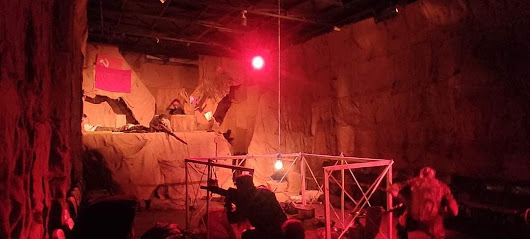The play’s
subplots either contribute to the main plot or divulge into the history of the
Maoist militants and Nepal Police officers.
That same question lies at the heart of a play happening at Purano Ghar
theatre in Sinamangal,
Set
against the backdrop of an escalating conflict between Maoists and Nepal
Police, the play has achieved a rare feat of offering a truly immersive and
vicarious theatrical experience, mainly through a clever and frankly ambitious
set design. The play’s focal point is its ability to create a physically vivid
and emotionally stirring theatrical experience.
While
the stage design was conceptualised by Bharati himself,
Daya
and Fulmati, are two lovers who have run away from their homes, or rather
banished from their homes, and live in a humble abode, abutting the only
pathway through the forest. Daya is from a so-called higher caste, and Fulmati
is from a so-called lower caste. Fulmati is also heavily pregnant and due to
deliver any day. Since their lives have been uprooted due to caste
discrimination, the couple’s sympathies lie with the Maoist forces that control
the forest area, the precious pathway through the forest, and a few adjoining
wards.
But
when Fulmati goes into labour, it is a lone Nepal Police officer who happens to
come across the house that is able to help them reach a nearby settlement and
safely deliver the baby.
Noticing
the couple's absence in their home, the Maoist militants become suspicious. A
new telephone tower has also been built without the knowledge of the Maoists
and they are enraged.
Nearby
the telephone tower, the Nepal Police have also established a barrack. Their
goal is to repel the Maoist militants and make the pathway that cuts across the
forest areas into a neutral area. This makes up the central conflict in the
play; the Maoists are unwilling to give up “even an inch of the land” whereas
the Nepal Police are willing to do whatever is necessary to fend off Maoist
control from the pathway.
While
the main conflict regarding the pathway moves along, many more subplots either
contribute to the main plot or divulge into the history of the Maoist militants
and Nepal Police officers. The Maoist members recall their past memories at
times—how they were brutally oppressed by their ‘masters’ or by other society
members. When a flashback occurs, the actors are blackened out, and another
part of the stage lights up, showing us the memory in real-time.
The
ingenious design of the theatre stage that encompasses all available space is
what allows the play to experiment with unbridled freedom. Typically when a
scene ends and a new scene with new props and settings begins, the lights are
switched off, and there are a few moments of downtime as stagehands and actors
scramble to change the props. But in ‘Khat’, each scene seamlessly transitions
into another without any downtimes—when one scene ends, the lights in that
stage area are switched off and another area of the stage illuminates to
continue the plot.
But the runtime of the play—one hour and 45 minutes—does get exhausting. Though the director has added interesting subplots and used flashback scenes in an innovative way, some scenes—like the one in which the police commander narrates the last letter of a colonel father to his soldier son—stretches the audience’s patience, making us question if the play is overstaying its welcome. Added on top of an abundance of traumatic events that happen one after another, the play can quickly get emotionally draining.
The
climax of the play also ends with a literal and metaphorical bang. Director and
writer Bharati has made use of all possible resources and props to recreate the
chaos of a conflict zone and he has succeeded. As the smell of gunpowder wafts
through the air of the theatre, the audience are left dazed, confused, and
overwhelmed. The climax, which culminates in an all-out battle between the
Maoist and Nepal Police forces, showcases how conflicts and battles during war
can be spurred on by unforeseeable factors. The irony of war—violence being
used to forge peace—is imbued in the final scenes.
The
intention of the play seems to be a realistic portrayal of “people’s war” and
it succeeds, albeit a bit too well. There are no black and white distinctions
in a war; all the violence and carnage bleeds into a grey area where it gets
difficult to assign blame to a particular group. The play forces us to
acknowledge this reality of war. In the end, all the ambitious dreams,
senseless violence, and unmeasurable sacrifices fizzle into nothing.
On
April 2, Paradym TV released a YouTube video titled “देश के हो?” - Young
People react to ‘Pir’ by Prakash Saput. In the video, four Nepali
youths watched, reacted, and discussed the latest music video about the lives
of ex-Maoist militants after the Maoist revolution. The youths were then asked
about their knowledge of the decade-long “people’s war”, and they were almost
oblivious to it. The video then started a wave of online
discourses regarding the need to create awareness of
Spanish
philosopher George Santayana in 1905 had written,“Those who cannot remember the
past are condemned to repeat it.” Winston Churchill in 1948 had given a speech
to the House of Commons in 1948, paraphrasing Santayana’s quote, “Those that
fail to learn from history are doomed to repeat it.” The onus is on us now to
remember the past and learn from history.
“More
than 17,000 people died during the war. What was it all for?” asks Bharati. “We
are forgetting our history and this play is my humble attempt to provide a
glimpse of our past.”
‘Khat’ is being staged at Purano Ghar theatre, Sinamangal until April 27.
PURANO GHAR
Sinamangal, near KMC Hospital.
5:00 pm everyday except Monday









.jpg)





0 Comments